Nestled in the heart of Gifu Prefecture, Gujo Hachiman is a charming castle town that remains one of Japan’s best-kept secrets. Though often overlooked in travel guides, this hidden gem offers a blend of history, culture, and natural beauty that makes it an ideal day trip destination. If you are looking for a day trip that will have you feeling like you stepped straight into a Studio Ghibli movie, look no further than Gujo Hachiman.
Article Contents
A Brief History of Gujo Hachiman

Founded in the 16th century by the feudal lord Endo Morikazu, Gujo Hachiman has a rich history that’s deeply intertwined with the natural surroundings. Its remote location in a secluded valley has allowed the town to preserve many of its traditional practices, offering visitors a glimpse into Japan’s past. Gujo Hachiman played a significant role as a trade route for travelers journeying along the Nagara River from Nagoya to the Sea of Japan.
After a fire destroyed the original town, Endo Tsunetomo, a descendant of Morikazu, took on the task of rebuilding. Understanding the importance of water in daily life, Tsunetomo designed a network of small waterways connected to the rivers that flow through the town. These channels are still in use today, and locals use them for everything from washing vegetables to refrigeration and laundry. As you explore the town, you’ll often spot colorful koi fish swimming in these clear waters, adding to the town’s tranquil ambiance.
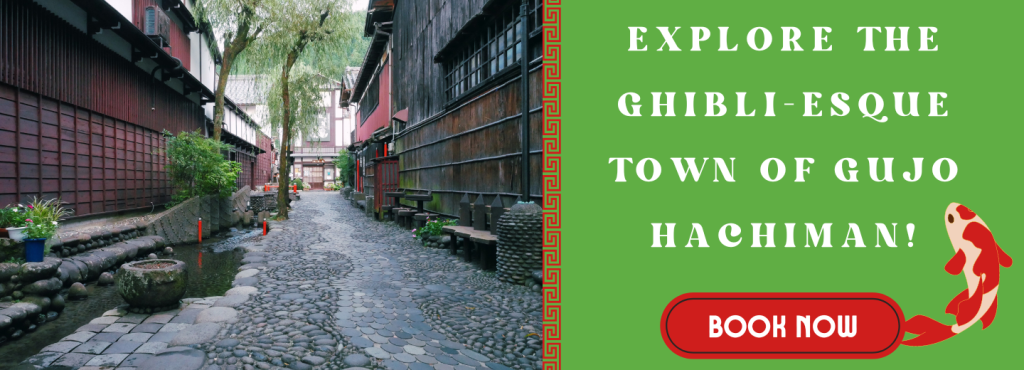
The Festivals
Gujo Odori
With a population of less than 40,000, Gujo Hachiman is quiet and peaceful for most of the year. However, it comes alive during the summer months with the Gujo Odori, one of Japan’s most famous Bon Dance festivals. This centuries-old tradition begins in mid-July and continues until early September, drawing visitors from all over Japan (and the world!) for over thirty nights of dancing. The festival reaches its peak during the Obon holiday in mid-August when over 250,000 visitors visit every year. The dancing starts at 20:00 and goes until 22:30 (or later) on most days, but during special dates in August, people will be dancing until sunrise! Check out the 2024 schedule here.
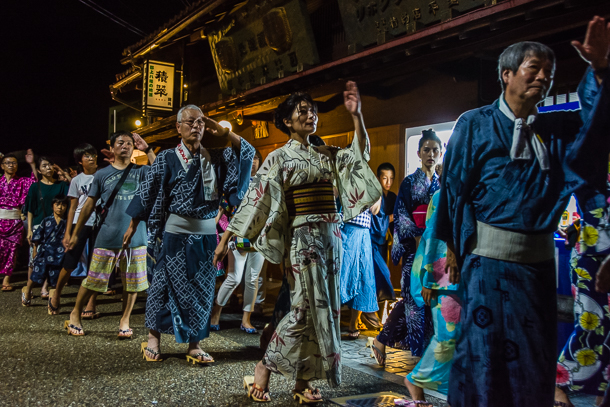
During the Gujo Odori, the streets are filled with the sounds of traditional music, played on instruments like the Shamisen, bamboo flute, and Taiko drum. The dances themselves consist of simple and easy-to-learn steps performed while walking in a circular pattern. Locals are always eager to teach newcomers the steps, creating a warm and inclusive atmosphere that embodies the spirit of the festival. You don’t need any special clothing or equipment to participate either; however, if you want to fully experience the dance, we recommend buying a pair of traditional geta sandals (more info below.) You will also be working up a sweat during the summer months, so having a Tenugui towel to wipe your face is also recommended! Make a tenugui towel your own on our Gujo Hachiman day tour.
Winter Festival Kanzarashi

This special festival occurs only twice a year on the coldest days of winter, usually at the end of January and beginning of February. This festival brings people together to prepare the Koinobori, or carp streamers, which fly during the spring festivals celebrating children. In the afternoon, you can watch as artists use traditional methods to paint and dye the colorful fabrics, later submerging them in the icy Nagara River overnight. Watching the fabrics floating in the river is certainly a sight to behold.
Exploring Gujo Hachiman: Top Attractions
Waterways
The town’s waterways are one of its most distinctive features. The town is bisected by two rivers, the Nagara and the Yoshida, and in summer it is common to see children swimming in their cool waters.

Inside the town, you can stroll along Igawa Lane, a picturesque canal that’s home to dozens of koi fish. These koi are exceptionally large as they are fed daily by locals and tourists. You can feed them too – food dispensers sell handfuls of food for only 100 yen.

If you keep an eye on the small canals that run through the city, you might notice some small dam-like structures. These are used to make water easier to access for things like washing clothes and vegetables. You might also find a stray koi or two!
Lastly, make sure to stop by at the Sogisui Shrine. This small shrine to the god of water has crystal clear spring water that locals have used in their daily lives since ancient times. It was named after famous 15th century poet Iio Sogi, who composed much of his famous poetry while sitting beside it.
Gujo Hachiman Castle

Perched atop a mountain, Gujo Hachiman Castle offers stunning views of the town and surrounding valley. The castle is surrounded by maple trees, making it a great spot to visit if you are looking to view autumn leaves. Originally built in 1559, the castle has been restored and now serves as a museum, where visitors can learn about the town’s history and the samurai who once ruled here.
Gujo Hachiman Castle (郡上八幡城)
Entry Fee: adults 400 yen, school children 200 yen
Opening hours: 8:00-18:00 (may change seasonally)
Address: Japan, 〒501-4214 Gifu, Gujo, Hachimancho Yanagimachi, 一の平 659
Website (Japanese only) | Google Maps
Gujo Hachiman Hakurankan City Museum

This museum is a great starting point for anyone interested in the town’s history and culture. Exhibits include traditional crafts, historical artifacts, and a detailed look at the Gujo Odori festival.
The museum also offers demonstrations of the dances performed during Gujo Odori, mainly on Saturdays, Sundays, and holidays.
Gujohachiman Hakurankan Museum (郡上八幡博覧館)
Entry Fee: free
Opening hours: 9:30-17:00
Address: 50 Hachimancho Tonomachi, Gujo, Gifu 501-4213
Website (Japanese only) | Google Maps
Plastic Food “Sanpuru” Workshop

Gujo Hachiman is famous for its plastic food replicas, which are used by restaurants across Japan to display their dishes. At the Sample Kobo workshop, you can try your hand at making your own food replicas, from tempura and lettuce, to spilled ice cream or milk. It’s a fun and quirky activity that’s perfect for all ages.
Sanpuru Kobo Ltd.
Workshop Fee: 1500-3000 yen, depending on the item
Opening hours: 10:00-17:00
Address: 956 Hachimancho Hashimotocho, Gujo, Gifu 501-4227
Website (Japanese only) | Google Maps
Hands-On Cultural Experience: Tenugui Making

Gujo is also known for its silk screen printing, and one of the most popular things to make using this technique are the traditional towels known as Tenugui. These towels are used for wiping sweat off your hands and face during the hot summer nights of the Bon Dance Festival. These towels are hand-dyed using special stamps, and can be customized with a myriad of different dyes and patterns.
Takara Gallery Workroom
Workshop Fee: 1,200-2,200 yen
Opening hours: 10:00 – 17:00 (closed Tuesday and Wednesday)
Address: 501-4222, Hachiman-cho, Gujo-shiShimadani 470-28
Website | Google Maps
Interested in making a Tenugui towel? Join our tour which includes a visit to a local workshop, and you will have the opportunity to make one yourself!

Shop for Geta

If you are hoping to attend the Gujo Odori, make sure to grab a pair of the traditional wooden clogs known as Geta. This local shop handmakes their Geta from cypress trees grown in the mountains around Gujo Hachiman. You can also buy other accessories like Tenugui towels and drawstring purses.
Gujo Mokuri (郡上木履)
Opening hours: 11:00 – 17:00 April – September, Reservation only October-March
Address: 501-4227, Hachiman-cho, Gujo-shi, Hashimoto 908-1-1
Website (Japanese only) | Google Maps
Savoring Local Flavors: Where to Eat
Gujo Hachiman is also a foodie’s paradise, offering a range of local specialties that showcase the region’s unique flavors.
Goheimochi at Higashi no Kumaya

This fifth-generation takeaway shop is famous for its Goheimochi, a grilled rice cake coated in a sweet and savory Miso sauce and served on a stick. It’s a perfect snack to enjoy while exploring the town.
Higashi no Kumaya (ひがしのくま家 おかずや五代目)
Opening hours: 10:00-17:00
Address: 874 Hachimancho Honmachi, Gujo, Gifu 501-4216
Access: From Gero Station, it’s an 8-minute walk.
Website | Google Maps
Gujo Ayu at Shinbashi Tei

Ayu, a type of sweetfish native to Japan’s rivers, is a local delicacy in Gujo Hachiman. Shinbashi Tei offers Ayu set meals along with other regional dishes like Hida beef grilled on a magnolia leaf or Keichan, which is Gifu’s special grilled chicken stir fry.
Shinbashi-tei (新橋亭)
Opening hours: Lunch 11:00-14:40, Dinner 17:00-20:00
Address: 268-3 Hachimancho Yanagimachi, Gujo, Gifu 501-4214
Website (Japanese only) | Google Maps
Matcha Desserts at Sogi-an

For those with a sweet tooth, Sogi-an is the place to be. Enjoy a matcha latte float or matcha shaved ice (available in summer) while taking in the amazing historical Japanese atmosphere are the perfect treats to cool down after a day of sightseeing.
Sogi-an (お抹茶処宗祇庵)
Opening hours: 11:00-17:00, Closed on Wednesdays
Address: 862-10 Hachimancho Honmachi, Gujo, Gifu 501-4216
Website (Japanese only) | Google Maps
Gujo Craft Beer at Kobokobo

Beer lovers shouldn’t miss the chance to try Gujo Craft Beer at Kobokobo, a local brewery that offers a variety of unique and refreshing brews.
Gujo Hachiman Beer Kobokobo
Opening hours: Weekends only, Saturday 13:00-18:00, Sunday 13:00-17:00
Address: 939 Hachimancho Shinmachi, Gujo, Gifu 501-4226, Japan (located inside ゲンリン)
Website (Japanese only) | Google Maps
Soba at Sobasho Matsui

If you’re in the mood for something hearty, head to Matsui for a plate of handmade soba noodles. This traditional dish is a staple in Japanese cuisine, and Matsui’s version is not to be missed.
Sobasho Matsui (蕎麦正まつい)
Opening hours: 11:00 until sold out, closed
Address: 774-2 Hachimancho Kajiyamachi, Gujo, Gifu 501-4218
Website (Japanese only) | Google Maps
Where to Stay
To fully immerse yourself in the charm of Gujo Hachiman, consider spending the night at one of the town’s traditional inns.
Mihara Ryokan

Located in the heart of town, Miharaya Ryokan offers a quintessential Japanese experience, with tatami-mat rooms, futon bedding, and a warm, welcoming atmosphere.
Miharaya Ryokan
Address: 266 Hachimancho Yanagimachi, Gujo, Gifu 501-4214
Website (Japanese only) | Google Maps
Hotel Sekisuien

For those who prefer a more modern stay, Hotel Sekisuien provides comfortable accommodations with all the amenities you need. The hotel’s location makes it easy to explore the town’s attractions.
Hotel Sekisuien (ホテル積翠園)
Address: 511-2 Hachimancho Yanagimachi, Gujo, Gifu, 501-4214
Website (Japanese only) | Google Maps
How to Get There

To get to Gujo Hachiman from Nagoya Station, take the Tokaido line to Gifu Station. Then, transfer to the bus bound for (岐阜~八幡) Hotel Gujo Hachiman. The trip takes about 2 hours and costs ¥2180.
Conclusion
Whether you’re drawn by the allure of the Gujo Odori, the serene beauty of the waterways, or the rich history and culture, Gujo Hachiman offers an unforgettable experience that’s well worth the journey. This hidden gem in Gifu Prefecture invites you to step back in time, dance under the stars, and discover the magic that lies within Japan’s lesser-known towns. So next time you’re planning a trip to Gifu, make sure Gujo Hachiman is at the top of your list – you won’t regret it.
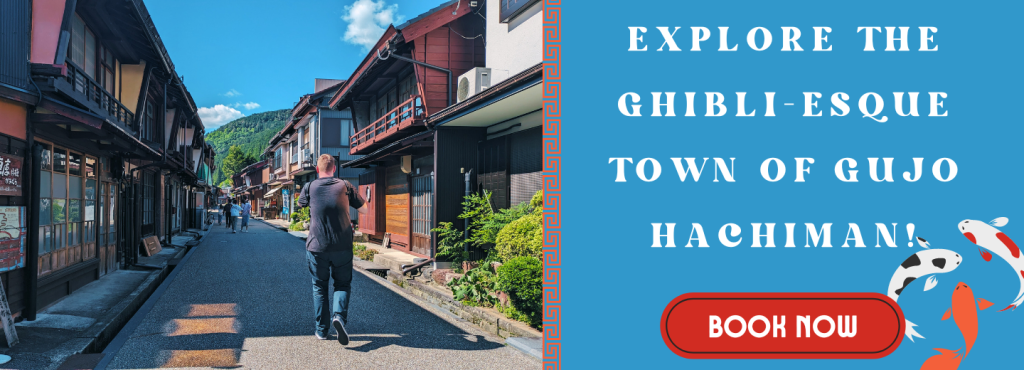
Did you enjoy this article?
Make sure to also check out our other posts about Nagoya and its surroundings and trust us if we say Nagoya is not boring!
Be sure to follow us on Facebook for regular updates on Nagoya, and see our Instagram for pictures and stories about the city!
Tag us 📲
Would you like to visit Gero Onsen, or have visited in the past? Let us know in the comments or on social media and tag us with #nagoyaisnotboring



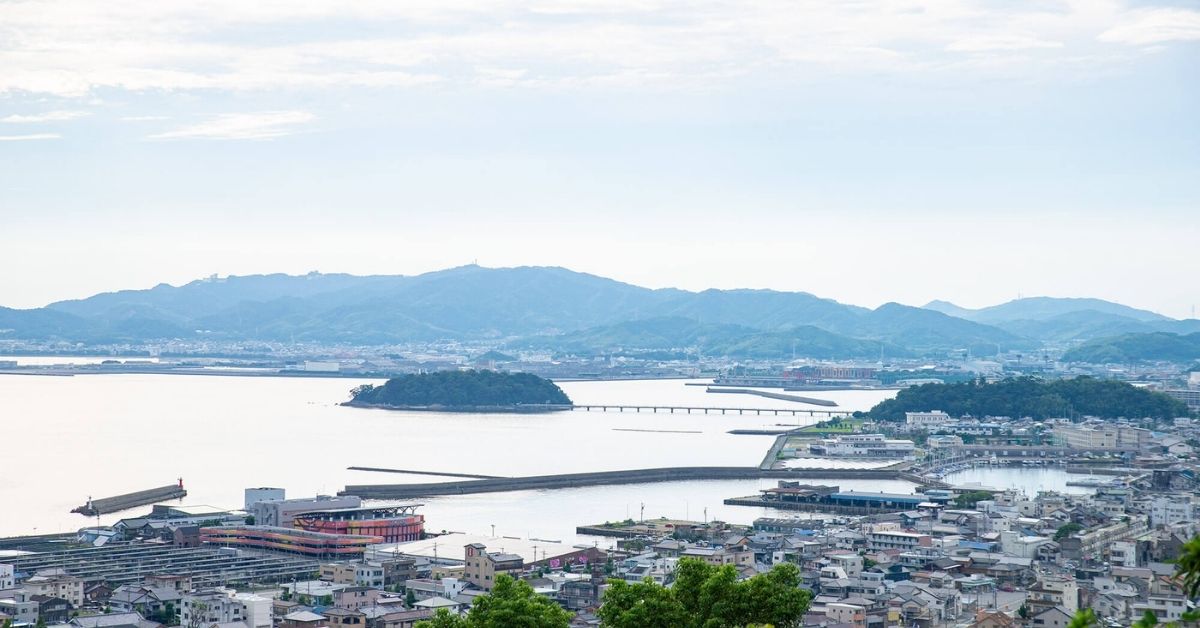





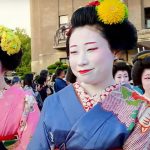
Great article! I’m curious, is Gujo Hachiman easy to reach from major cities like Nagoya? Also, any tips on where to stay if planning to catch the whole festival season?
Thank you!
And yes! it is reachable from Nagoya. In fact we do offer a tour for this amazing destination:https://www.nagoyaisnotboring.com/tour/gujo-hachiman-day-tour/